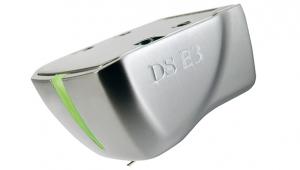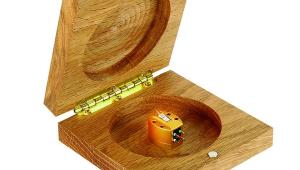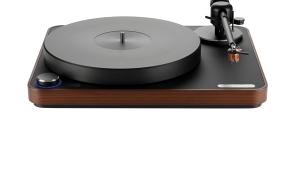B&O Beogram 4000 (Vintage)

The basic structure comprised a die-cast tray that served as the basis for the slim and elegant plinth. This housed another casting, which formed a floating sub-chassis. The suspension was constructed using three arched spring steel strips from which the sub-chassis hung on fine wires. This provided highly effective isolation from external vibrations.
Onto the sub-chassis were mounted a substantial bearing for the platter along with polished chrome runners which supported the arm assembly. The arm was moved by a lead screw driven by a servo motor of the ironless core type: an expensive component.
The platter, another heavy casting, was belt driven. Rather than have the motor connected directly to the mains, the designers chose to run it from an internal precision oscillator. This made automatic speed selection a realistic proposition and removed the need to provide different motors for export (60Hz) markets. The speed could be fine-tuned and a stroboscope was fitted, viewable through a small window on the control panel through a series of lenses and mirrors!
A second arm carried a lamp and a photocell used to detect the presence and size of a disc. Following the command ‘On’, the arm would move inwards to the edge of the record and then lower automatically. If a 7in record was detected the speed would be automatically switched from the default 33.3rpm to 45rpm.
For cueing, pausing and track selection the arm could be moved manually using the four-way rocker plate, which formed the centre of the control panel. The system which controlled the automatic functions of the Beogram 4000 was implemented using digital integrated circuits and it was one of the first consumer products to employ this technology.
The arm was tipped with a moving-iron pick-up and this cartridge was unusual at the time because of its specific, non-replaceable stylus.
A compelling listen
The Beogram 4000 has a smooth, silky, luxurious sound that encourages long listening sessions. Vinyl surface noise is unusually well suppressed too, making quiet passages and the gaps between tracks sound almost CD-clean.
Furthermore, the use of tangential tracking means that distortion levels do not rise at the beginning and end of each side of the record (as they do with conventional arms), so after a while it is easy to forget that you’re listening to vinyl.
Mussorgsky’s Pictures At An Exhibition [RCA Victor] proved to be a compelling listen on the Beogram 4000. The recording requires a turntable which can set sudden bursts of activity against a quiet background, which the 4000 did exceptionally well.
The B&O rendered the percussion and woodwind, both of which occasionally become quite energetic, with an ease that left you wanting for nothing more.
At the bass end, the thundering subsonics of ‘Bydlo’ were both fulsome and accurate, suggesting that the sophisticated arm is at ease and well behaved. There was no loss of detail as each side came to a close (thanks to tangential tracking), so you are able to enjoy the likes of the ‘Ballet Of The Chicks In Their Shells’ as if it were optimally placed in the centre of the LP.
Along with an album of 12in remixes of Howard Jones tracks, The Pet Shop Boys’ Introspective and Kate Bush’s The Kick Inside, one of the LPs we tried was Orchestral Manoeuvres In The Dark’s Architecture And Morality [Dindisc].Here, we found that the Beogram 4000 possessed surprisingly good timing for a belt-driven deck.
Verdict
This very early example of a tangential-tracking turntable shows just what the system is capable of when implemented with care. It is also very easy to use, its automation is foolproof, and it looks downright stunning, too
Originally published in the 2014 Yearbook
























































